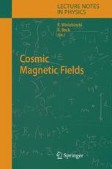Search
Search Results
-
Magnetic Fields in Galaxies
Magnetic fields are a major agent in the interstellar medium. They contribute significantly to the total pressure which balances the gas disk against...
-
Magnetic Fields in Galaxy Systems, Clusters and Beyond
The discovery of significant magnetic fields beyond our Milky Way was unwittingly made in the early 1950’s when new “discrete” cosmic radio sources...
-
Stellar Magnetic Fields
Stellar magnetic fields are directly detected or inferred across the whole Hertzsprung--Russell Diagram. Attention in this chapter is concentrated on...
-
Magnetic Fields in Diffuse HI and Molecular Clouds
The diffuse interstellar HI is the matrix within which many molecular clouds reside and the medium that soaks up the energy injected by sources such...
-
Magnetic Fields in the Early Universe
A substantial magnetic field could conceivably have been generated in the ultra-early Universe. However, the relevant physics at those eras is very...
-
Introduction
We summarize the topics presented in this book, and when appropriate we enlighten cross–references among the different topics: high precision and...
-
Cosmological Applications of Loop Quantum Gravity
After a brief introduction to classical and quantum gravity we discuss applications of loop quantum gravity in the cosmological realm. This includes...
-
Quantum Corrections to Scalar Quintessence Potentials
We give a brief introduction into the formalism of the effective action. We use the effective action to investigate the stability of scalar...
-
The Accelerating Universe and Dark Energy: Evidence from Type Ia Supernovae
I discuss the use of Type Ia supernovae (SNe Ia) for cosmological distance determinations. Low-redshift SNe Ia (...
-
Infering Annihilation Channels of Neutralinos in Galactic Halos
Applying the microcanonical definition of entropy to a weakly interacting and self–gravitating neutralino gas, we evaluate the change in the local...
-
Electroweak Baryogenesis and Primordial Hypermagnetic Fields
The origin of the matter-antimatter asymmetry of the universe remains one of the outstanding questions yet to be answered by modern cosmology, and...
-
Inflation
The optimistic picture for the explanation of the baryon-antibaryon asymmetry that we apparently obtain with grand unified theories has one serious...
-
Standard Synthesis
One of the two most important observations that indicate a hot past of the universe is the universal distribution of helium and deuterium. Deuterium,...
-
Topological Concepts in Gauge Theories
In these lecture notes, an introduction to topological concepts and methods in studies of gauge field theories is presented. The three paradigms of...
-
1 An Introduction to the Physics of the Early Universe
We present an elementary introduction to the Early Universe. The basic features of the hot Big Bang are reviewed in the framework of the fundamental...
-
Basics
Telescopes of all kinds look deep into the sky and find planets, stars, the Milky Way, other galaxies, clusters of galaxies, the large-scale...
-
Topological Quasi-Particles
The subject of topology is the set of properties of relative positions that can be defined without the use of metric properties. A metric induces a...
-
Anthropic Aspects
Cosmology attempts to understand the observable metagalaxy as a representative part of the universe and as a necessary consequence of the laws that...
-
Higher Dimensions
The invariance group of mechanics and field theory tells us that space has three dimensions, and space-time four. Nearly all physical theory uses...
-
Chiral Anomalies and Topology
When a field theory has a symmetry, global or local like in gauge theories, in the tree or classical approximation formal manipulations lead to...
